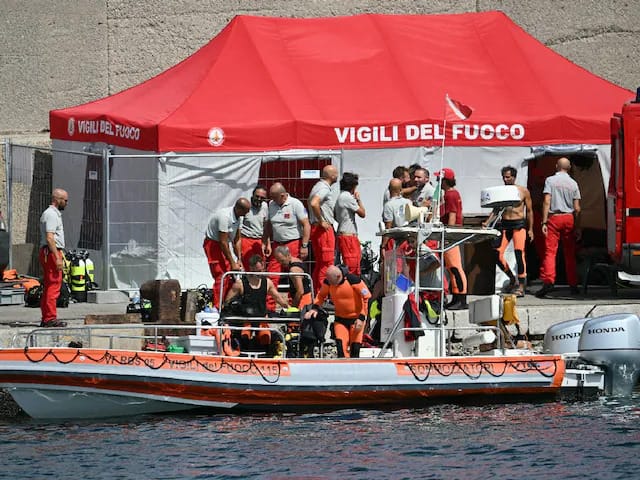Superyacht sinking: Sicilian wreckage search uncovers bodies
Questions abound about what caused the superyacht, which was built in 2008 by Italian shipyard Perini Navi, to sink so quickly, when the nearby Sir Robert Baden Powell sailboat was largely spared and managed to rescue the 15 survivors.

Divers searching the wreck of a superyacht that sank off Sicily found four bodies Wednesday, as the search continued for two more missing passengers and questions intensified about why the vessel sank so quickly.
Divers and rescue crews unloaded two body bags from the rescue vessels that pulled into port at Porticello. Salvatore Cocina, head of the Sicily civil protection agency, said two other bodies had also been found Wednesday in the wreckage for a total of four.
The discovery indicated that the operation to search the hull on the seabed 50 metres underwater was a recovery one, not a rescue, given the amount of time that had passed and no signs of life had emerged over three days of searching, maritime experts said.
The Bayesian, a 56-metre British-flagged yacht, went down in a storm early Monday as it was moored about a kilometre offshore. Civil protection officials said they believed the ship was struck by a tornado over the water, known as a waterspout, and sank quickly.
Fifteen people escaped in a lifeboat and were rescued by a nearby sailboat. One body was recovered Monday — that of the ship’s Antigua-born chef, Recaldo Thomas.
Investigators from the Termini Imerese Public Prosecutor’s Office, meanwhile, were acquiring evidence for their criminal investigation, which they opened immediately after the tragedy even though no formal suspects have been publicly identified.
Questions abound about what caused the superyacht, which was built in 2008 by Italian shipyard Perini Navi, to sink so quickly, when the nearby Sir Robert Baden Powell sailboat was largely spared and managed to rescue the 15 survivors.
Was it merely the case of a freak waterspout that knocked the ship to its side and allowed water to pour in through open hatches? What was the position of the keel, which on a large sailboat such as the Bayesian might have been retractable, to allow it to enter shallower ports?

“There’s a lot of uncertainty as to whether it had a lifting keel and whether it might have been up,” said Jean-Baptiste Souppez, a fellow of the Royal Institute of Naval Architects and the editor of the Journal of Sailing Technology. “But if it had, then that would reduce the amount of stability that the vessel had, and therefore made it easier for it to roll over on its side,” he said in an interview.
Yachts such as the Bayesian are also required to have watertight, sub-compartments that are specifically designed to prevent a rapid, catastrophic sinking even when some parts fill with water.
“So for the vessel to sink, especially this fast, you are really looking at taking water on board very quickly, but also in a number of locations along the length of the vessel, which again indicates that it might have been rolled over on its side,” Souppez said.
Italian coast guard and fire rescue divers, meanwhile, continued the underwater search in dangerous and time-consuming conditions. Because of the depth of the wreck — which is far deeper than most recreational divers are certified for and at a depth that requires special precautions — divers working in tag teams can only spend about 12 minutes at a time searching.
The limited dive time is designed in part to avoid decompression sickness, also known as the “bends,” which can occur when divers stay underwater for long periods and ascend too quickly, allowing nitrogen gas dissolved in the blood to form bubbles.
“The longer you stay, the slower your ascent has to be,” said Simon Rogerson, the editor of SCUBA magazine. He said the tight turnaround time suggests the managers of the operation are trying to limit the risks and recovery time after each dive.
“It sounds like they’re operating essentially on no decompression or very tight decompression, or they’re being extremely conservative,” he said.






